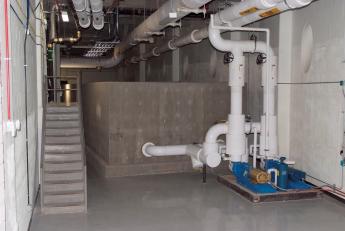Denver Building Named #2 in Carbon Emission Reduction
The Byron Rogers Federal Building (FB) in downtown Denver was recently named as second best in the world for energy savings in a report by the New York State Energy Research and Development Authority (NYSERDA).
This report named 18 high-rise buildings that had completed deep energy retrofits to reduce carbon emissions from the U.S, Canada, England and Japan, with only the United Nations Building having a better rating than the Byron Rogers FB.
The NYSERDA study selected projects that had measurable and verifiable pre- and post-retrofit energy data and then asked four key questions as the basis to compare each of the buildings. These questions were:
- What energy savings are achievable?
- What building systems were upgraded?
- What technology was deployed?
- What were the obstacles and opportunities?
“With the American Recovery and Reinvestment Act (ARRA), there were some energy executive orders passed that really became a focus for projects to reduce our energy,” said Bryan Zach, project manager for the modernization project. “That really became one of the primary objectives and drivers for designing the energy retrofits for the Byron Rogers Federal Building.”
Originally built in 1965, renovations for the Rogers FB took place from 2012-2014 to modernize critical systems using ARRA funds. The cost of the project was approximately $159 million for the 494,000 square foot facility.
The building received what is known as a full-gut renovation that reorganized the core building functions to make them more efficient and flexible to the changing conditions found in this high altitude. Improvements focused on heating/cooling systems and high efficiency lighting as well as external modifications such as window replacement and a new facade.

The retrofit replaced 30-50 year old technology with more efficient, higher quality modern equipment.
“This building had to comply with the 2007 Energy Independence and Security Act that required a certain percent reduction (in emissions),” said Bill Green, President of the RMH Group. “We had to demonstrate that we could meet or achieve that energy reduction.”
Prior to the retrofit, carbon emission data collected from the Rogers FB showed an output of 94 thousand British thermal units per square foot (kBtu/sf) when tested in 2009. New tests after the upgrades were installed in 2018 showed carbon emissions dropped 55% to 42 kBtu/sf, the deepest energy saving found in the NYSERDA study.
Most of the upgrades were completed during a period of low occupancy but since then more federal agencies have moved into the building because of the modernization.
Not only did the government save money on energy reduction but it is also seeing value in footprint optimization as well as lease cost savings by bringing more agencies into the Rogers FB.

 U.S. General Services Administration
U.S. General Services Administration